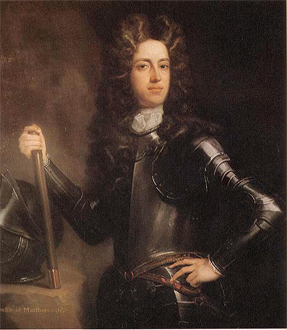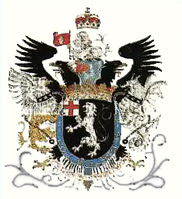John Churchill, Duke of Marlborough
From the Quicksilver Metaweb.
This is a page for the 1st Duke of Marlborough
Stephensonia
He'd be the General Douglas MacArthur of this era.
Authored entries
- Daniel Waterhouse (Alan Sinder)
- Judge Jeffreys (Alan Sinder)
- Stephenson:Neal:Quicksilver:8:King Carlos the Sufferer(Alan Sinder)
- Stephenson:Neal:Quicksilver:18:...behaving as if Queen Anne were already dead and buried,... (Alan Sinder)
- Stephenson:Neal:Quicksilver:21:Mister Clarke had to get in line (Alan Sinder)
- Stephenson:Neal:Quicksilver:176:Black Velvet (Scott Elkin)
- Stephenson:Neal:Quicksilver:400:Winston Churchill (Neal Stephenson)
- Stephenson:Neal:Quicksilver:613:the previous twelve years (Neal Stephenson)
- Stephenson:Neal:Quicksilver:704:King's Own Black Torrent Guards (Neal Stephenson)
Wikipedia: John Churchill, 1st Duke of Marlborough
John Churchill, 1st Duke of Marlborough (May 26, 1650 - June 16, 1722), in full Captain-General Sir John Churchill, K.G., P.C., 1st Duke of Marlborough, Earl of Marlborough, Baron Churchill of Sandridge in Hertfordshire, Lord Churchill of Eyemouth (in addition to these English and Scottish titles he was also Prince of Mindelheim and a Prince of the Holy Roman Empire), was an English military officer during the War of the Spanish Succession.
John Churchill
1st Duke of Marlborough
John Churchill was born to Elizabeth and Sir Winston Churchill (the more famous holder of that name is a descendant) in the immediate aftermath of the English Civil War. His father had fought for the Royalists during the conflict and had suffered badly for it -- they lived in very modest circumstances until the end of the Commonwealth. His staunch support for Charles II of England paid off with the return of the king, however, and one of the fruits of this was the appointment of 17-year-old John Churchill to the household of the man second in line to the throne, then-Lord High Admiral, the Duke of York. Joining the navy, he remained at court for a while, but saw turns of duty first in the Mediterranean and in the last of the Anglo-Dutch Wars. In the latter, he became a Marine officer, and was attached to the siege of Maastricht, his first taste of land battle. Having come to the attention of the French crown during this action, he moved onto the fighting in Alsace, where he fought with one of the leading generals of the day, Marshal Turenne.
That war ended in 1674, and Churchill settled down to peaceful life. In 1678, he married Sarah Jennings, who would come to fiercely present his interests at court while he was off fighting on the Continent. In 1682, then-Colonel Churchill entered the Scotch peerage as Lord Churchill of Eyemouth. In the years to follow he engaged in various diplomatic missions to Spain and their former enemy, the Dutch United Provinces, largely in opposition to French interests. In 1685, Charles II died without legitimate issue, and Churchill's former employer, the Duke of York, became James II of England. Shortly thereafter James elevated him to the peerage as Baron Churchill of Sandridge in Hertfordshire.
Within a few months, the new king faced a series of rebellions, one of which was by the Duke of Monmouth. Churchill was promoted major-general in July 1685 and appointed head of the loyalist troops, then quickly subordinated to the Earl of Feversham. It is believed that this lack of confidence was what eventually turned Churchill from loyalty to the Stuart kings. Churchill nevertheless distinguished himself during the fighting, and became an important figure in the army.
In 1688, William of Orange invaded England with the support of most of the nobility, as James II was a Catholic and appeared to be on the road to introducing absolutist rule into his kingdom. James promoted Churchill to lieutenant-general in November and ordered him to engage and defeat the invaders; instead he deserted to the Orange cause, which caused most of the army to come with him and put James into a very difficult position. He quit the country for France rather than fight. The Glorious Revolution had been pulled off with far less bloodshed than anyone expected, and the Stuarts no longer ruled in Britain. In reward Churchill was appointed a Privy Councillor (hence the postnominal abbreviation "P.C.") in February 1689 and created Earl of Marlborough in April.
Marlborough was out of the public sphere to a large extent for the next few years, as William III did not entirely trust the Stuart supporter. During this time, his most notable activity was some time as the Governor of the Hudson's Bay Company. The Canadian town of Churchill, Manitoba, a former Company outpost, gains its name from this connection.
He returned to the forefront with events leading up to the War of the Spanish Succession in 1701. The grandson of the King of France, Louis XIV, was put forward as heir to the throne of Spain, and rather than allow France to expand its power to such a great extent, a coalition of European powers (including Britain) prepared for war. Marlborough was first put to use commanding English and Dutch forces opposing the Swedish allies of France. He was successful in this, and when William died in 1702, Marlborough was reaching his peak.
William's successor, Queen Anne, was a close friend of Marlborough's wife, and he enjoyed the new queen's confidence and favour; immediately upon her succession to the throne he was knighted as a member of the Order of the Garter (hence the postnominal abbreviation "K.G."), appointed captain-general of the English troops, and made Master-General of the Ordnance. The same year, the War of the Spanish Succession with France finally broke out into the open and Captain-General the Earl of Marlborough was made commander-in-chief of the Allied armies. Despite the intransigence of his Dutch troops, Marlborough won a series of victories in 1703 and was created Duke of Marlborough, as well as his creation within the Empire as a Prince of the Empire and Prince of Mindelheim. The war continued, however, and in combination with Prince Eugene of Savoy he soundly defeated the French at the Battles of Blenheim and Ramillies.
Things were taking a turn for the worse in Spain, however, and his wife's friendship with the queen was gradually falling apart. Despite the earlier defeats, the French refused to give in, and continued attacking that part of the Low Countries or the Netherlands that was later to become Belgium. By 1708 he had had to fight a pitched battle against French forces once again, this time winning the Battle of Oudenarde. One more win followed at the Battle of Malplaquet in 1709. In Britain, however, the Whig Party had come to power and continued undermining the relationship he had with Anne. By 1711 he was recalled from the Continent, accused of embezzlement, and sent into a brief exile. The war ground on and eventually ended in mutual exhaustion in 1714.
Anne died shortly thereafter, and once again Marlborough was back in favour of British royalty, putting up funds in support of the Elector of Hanover. The Elector became king as George I, and Marlborough returned to England and settled into retirement. He spent most of his remaining days working on his new home, Blenheim Palace, and died in 1722.
Dukedom of Marlborough
The Dukedom of Marlborough is a hereditary title of British nobility. The first holder of the title was John Churchill, 1st Duke of Marlborough (1650 - 1722), the noted English/British general, and indeed an unqualified reference to the Duke of Marlborough in a historical text will almost certainly be a reference to this man.

The Family Crest
The Duke of Marlborough holds certain subsidiary titles: Marquess of Blandford (created 1702), Earl of Sunderland (1643), Earl of Marlborough (1689), Baron Spencer of Wormleighton (1603) and Lord Churchill (1685). (The Lordship of Churchill is in the Scottish peerage, while the rest are in the English peerage.) The title Marquess of Blandford is used as the courtesy title for the Duke's eldest son and heir.
The later Dukes of Marlborough are descended from the first duke, but not in the male line. Because the first duke had no sons, the title was allowed (by a special Act of Parliament) to pass to his eldest daughter in her own right. A younger daughter, Lady Anne Churchill, married Charles Spencer, 3rd Earl of Sunderland (c. 1674 - 1722), and from this marriage descend the modern Dukes of Marlborough. They therefore originally bore the surname Spencer. However, George Spencer, the 5th Duke of Marlborough, obtained a Royal Licence to assume and bear the additional surname and arms of his famous ancestor, the 1st Duke of Marlborough, and thus became George Spencer-Churchill. This double-barrelled surname has remained in the family to this day.
The 7th Duke of Marlborough was the paternal grandfather of the British Prime Minister Sir Winston Churchill. The present Duke of Marlborough is John George Vanderbilt Spencer-Churchill, 11th Duke of Marlborough.
Marlborough's notable descendants include Georgiana, Duchess of Devonshire, Winston Churchill, Diana, Princess of Wales and her namesake, an 18th century Lady Diana Spencer.
TV: The Churchills
John and Sarah Churchill were The First Churchills in the BBC television series with that title.
Related entries
- Winston
- Stephenson:Neal:Quicksilver:Reference Bibliography
- Charles II
- James II
- Monmouth
- William of Orange
- William III
- Hudson's Bay Company
- Louis XIV
- Queen Anne
- George I
External Links
- ISBN 0226106349 Sir Winston Churchill's Marlborough, his life and times, a biography.